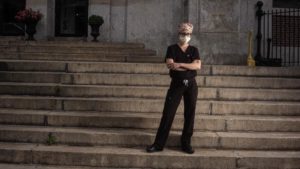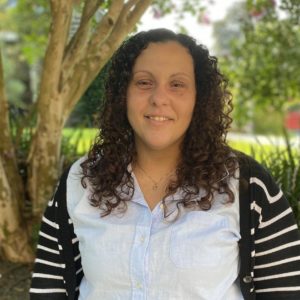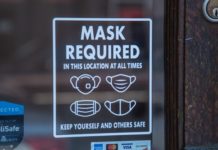
Before the pandemic, Natanya Gornstein-Talotti, the school nurse at Penn Alexander School in West Philadelphia, would see 20 students in her office per day at most. Now, she typically treats twice that number.
The only medical professional in the building, Gornstein-Talotti is tasked with testing students with an array of symptoms for COVID, in addition to handling the ordinary scrapes, bonks and bruises kids experience.
But with the fear of COVID still very much on people’s minds, teachers are much more sensitive to students’ ailments, even those once deemed unremarkable.
“Now it’s one sniffle, and they’re in my office,” Gornstein-Talotti said.
Gornstein-Talotti is tired; she comes in early every day and hasn’t eaten lunch since the school year began four weeks ago.
She isn’t the only school nurse experiencing burnout.
In a Sept. 21 survey by the Philadelphia Federation of Teachers — the union of which Philadelphia public school nurses are a part — many nurses mentioned the amount of stress they experienced and the need for additional help and resources in schools.
Michele Perloff, the school nurse at Albert M. Greenfield Elementary School, believes that some just don’t understand what goes into the job.
“This is not just giving out boo-boo Band-Aids and ice,” she said.
For some Jewish school nurses, their Jewish values keep them coming back.
“Repairing the world, giving help anywhere that it’s needed, loving your neighbor as yourself,” said Jessica Rose, the nurse at Kohelet Yeshiva in Merion Station.
But the commitment isn’t always easy.
Perloff just returned to Greenfield after being hospitalized with a kidney infection. Though no longer sick, she cut her medical leave short because the school of 680 students was short-staffed on medical professionals.
“I probably came back a little too soon, but I need to be here,” Perloff said.
Like Gornstein-Talotti, Perloff has skipped lunch to treat the kids coming into her office.
The school district now mandates testing for asymptomatic children, per the recommendations of school nurses. But nurses say they don’t have the time to process all of the paperwork that comes with documenting testing data and consent forms, in addition to paperwork for non-COVID ailments.
When a student bumps their head on the playground and comes into the nurse’s office, for example, the nurse must conduct a concussive head check, complete documentation and call the child’s caregiver.
In addition to updating testing documents for hundreds of students, a single nurse is responsible for contract tracing at their respective schools, despite the school district telling them in August that it would not be their responsibility.
“Here we are four weeks later, and we’re doing all the contact tracing,” Perloff said.
Perloff has help from two Jefferson and Drexel University nursing students twice a week but still feels overwhelmed.
Risa Babitt, a nurse at Stephen Decatur Elementary School, also is expecting student help in the coming weeks. She is working 30 extra hours per week to conduct contact tracing.
Perloff and Babitt are not alone.
According to the Philadelphia Federation of Teachers, 52.6% of schools have contact tracing completed by school nurses, 30.9% completed by nurses and the Philadelphia Department of Public Health, and 6.2% of schools have contact tracing done solely by the PDPH. According to Perloff, there are 17 schools in the district without school nurses; seven nurses are on medical leave. The school nurse-to-student ratio stands at 1:1,500.
Even in private schools, there’s a nurse shortage, Rose said. When Rose worked at a public school, a school nurse there would visit a private school a couple of days a week to conduct checkups on students who needed one.
“Private school kids also need attention and help and care, more than just a day or two here and there,” Rose said.

Though understaffed, these nurses still feel as though they are the lucky ones; they have school administration that supports them; their schools enforce mask-wearing and social distancing when necessary.
Lack of support for nurses has come from elsewhere, they said.
The school district changes COVID guidelines frequently. There’s already been more than one COVID testing protocol change this year and, by the time nurses adjust to the new guidelines, they change again.
Gornstein-Talotti said this makes communicating with parents difficult. If a student is sent home with COVID-like symptoms or has to be isolated after testing positive, parents can get confused by out-of-date information on the school district’s website that conflicts with a school nurse’s instructions for the child.
“When we don’t know what we’re doing, or [parents] hear something else from someone else’s parents, it makes us look bad,” Gorstein-Talotti said.
Within the school, teachers want nurses to be more assertive in testing students and sending them home. For Babitt, it’s just not possible because of a lack of time and resources.
“We’re being seen as the bad guys in the building,” she said.
However, the greatest frustration for the nurses is the lack of support from the school district, where they are seen as second fiddle to teachers, though both groups are members of the teacher’s union.
Because they are part of the union, school nurses are required to have a license. According to Perloff, most school nurses have backgrounds that required additional medical certifications, as the school district wants “very highly qualified, educated, experienced people.”
Yet school nurses cannot attain National Board Certification with as much ease as teachers, Gornstein-Talotti said. Therefore, they are not eligible to receive the additional compensation teachers can receive when they pursue additional certifications.
The pay disparity between teachers and school nurses can reach up to $15,000, Gornstein-Talotti said.
“We’re doing two full-time jobs as one person, not being compensated,” Babitt said.
Even with a love for the job, sticking with being a school nurse is something Babitt is finding hard to do. As she nears retirement age, she’s considering expediting when she says farewell to being a school medical professional.
“I was thinking of going out a year from this coming January,” Babitt said. “But now I’m thinking sooner.”
[email protected]; 215-832-0741






